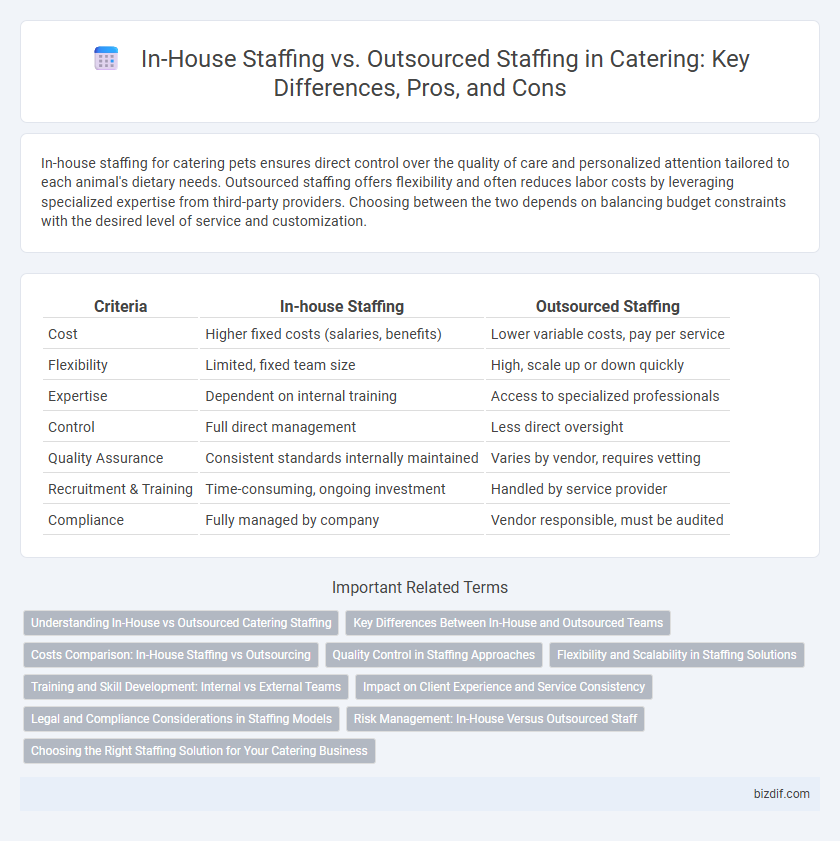In-house staffing for catering pets ensures direct control over the quality of care and personalized attention tailored to each animal's dietary needs. Outsourced staffing offers flexibility and often reduces labor costs by leveraging specialized expertise from third-party providers. Choosing between the two depends on balancing budget constraints with the desired level of service and customization.
Table of Comparison
| Criteria | In-house Staffing | Outsourced Staffing |
|---|---|---|
| Cost | Higher fixed costs (salaries, benefits) | Lower variable costs, pay per service |
| Flexibility | Limited, fixed team size | High, scale up or down quickly |
| Expertise | Dependent on internal training | Access to specialized professionals |
| Control | Full direct management | Less direct oversight |
| Quality Assurance | Consistent standards internally maintained | Varies by vendor, requires vetting |
| Recruitment & Training | Time-consuming, ongoing investment | Handled by service provider |
| Compliance | Fully managed by company | Vendor responsible, must be audited |
Understanding In-House vs Outsourced Catering Staffing
In-house catering staffing offers direct control over employee training, scheduling, and quality standards, ensuring consistency tailored to specific event needs. Outsourced catering staffing provides access to a flexible talent pool, reducing recruitment and management burdens while often bringing specialized skills and scalability for large or varied events. Evaluating factors like cost efficiency, reliability, and event complexity can guide the choice between maintaining dedicated staff or leveraging external catering providers.
Key Differences Between In-House and Outsourced Teams
In-house catering staff offer direct control over operations, fostering consistent quality and alignment with company culture, while outsourced teams provide scalability and specialized expertise that can reduce labor costs. In-house teams typically require investment in recruitment, training, and employee benefits, whereas outsourced staffing shifts responsibility for workforce management to a third-party provider. Decision-making speed and adaptability often favor in-house staff, but outsourced services deliver flexibility to handle fluctuating event demands and specialized culinary needs.
Costs Comparison: In-House Staffing vs Outsourcing
In-house catering staffing involves fixed costs such as salaries, benefits, training, and equipment, leading to higher overhead expenses. Outsourcing staffing typically reduces labor costs through flexible contracts and eliminates expenses related to recruitment, employee benefits, and ongoing training. Businesses opting for outsourced catering staff can achieve significant cost savings by paying only for services rendered during events, improving overall budget efficiency.
Quality Control in Staffing Approaches
In-house staffing allows catering companies to maintain direct oversight of employee training and performance, ensuring consistent quality control tailored to specific company standards. Outsourced staffing provides flexibility and access to specialized talent but may introduce variability in service quality due to less direct supervision. Effective quality control in catering relies on stringent vetting processes and continuous communication, regardless of the staffing approach.
Flexibility and Scalability in Staffing Solutions
In-house catering staffing offers direct control and consistent team quality but may lack flexibility during peak demand or seasonal fluctuations. Outsourced staffing provides scalable workforce solutions, enabling rapid adjustments in staff levels to meet event size variations without the long-term overhead. Choosing between these options impacts operational agility and cost-efficiency in catering service delivery.
Training and Skill Development: Internal vs External Teams
In-house catering staff benefit from tailored training programs that align closely with company culture and specific service standards, enhancing consistency and operational efficiency. Outsourced teams often receive standardized training focused on broad industry best practices, which may result in faster onboarding but less customization to unique client needs. Investing in continuous skill development for internal teams fosters employee loyalty and adaptability, while external providers rely on their existing expertise and periodic updates to maintain service quality.
Impact on Client Experience and Service Consistency
In-house staffing enables greater control over service quality and allows for tailored training that aligns closely with the company's standards, enhancing overall client experience. Outsourced staffing offers flexibility and scalability but may encounter challenges in maintaining consistent service levels due to varying external team dynamics. Ensuring standardized protocols and continuous communication remains essential to achieve reliable service consistency regardless of staffing choice.
Legal and Compliance Considerations in Staffing Models
In-house staffing ensures direct control over compliance with labor laws, health regulations, and industry certifications, minimizing legal risks associated with catering services. Outsourced staffing involves navigating contractual obligations and vendor compliance standards, requiring thorough due diligence to avoid liability for third-party noncompliance. Understanding local labor laws, OSHA standards, and food safety regulations is critical in both models to maintain regulatory adherence and protect business integrity.
Risk Management: In-House Versus Outsourced Staff
In-house catering staff offer greater control over training and adherence to company-specific safety protocols, reducing risks related to food safety and customer service compliance. Outsourced staffing can introduce variability in staff expertise and reliability, potentially increasing risks associated with inconsistent service quality and liability issues. Effective risk management requires careful evaluation of contract terms, staff qualifications, and contingency plans to mitigate operational disruptions and maintain regulatory compliance.
Choosing the Right Staffing Solution for Your Catering Business
Choosing the right staffing solution for your catering business involves evaluating the benefits and challenges of in-house staffing versus outsourced staffing. In-house staff offer greater control, brand consistency, and direct supervision, ensuring personalized service aligned with your company values. Outsourced staffing provides flexibility, access to a broader talent pool, and cost efficiency, making it ideal for fluctuating event demands and seasonal peaks.
In-house staffing vs Outsourced staffing Infographic

 bizdif.com
bizdif.com